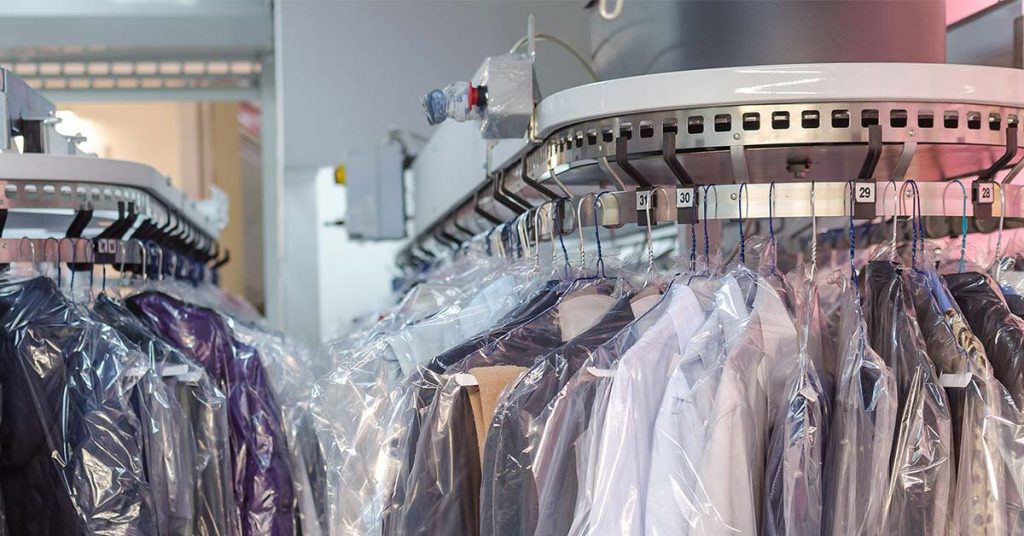Doing laundry has been a common household activity for years. Whether the technology was beating the garments on rocks by the river or pushing buttons on programmed washing machines, this process depends on water and a mechanical action usually assisted by soap or an alkali. The purpose of an alkali is to saponify the oils and dislodge ordinary soil and other matter. More often than not, the soapy agent holds soil in suspension as it becomes loose during the wash cycle, and is subsequently flushed away during the rinse cycle and centrifugal spin.
The drying process for doing laundry at home is either hanging clothes on a clothesline or tumbling them in a gas- or electric-heated dryer.
Dry cleaning, on the other hand, is different. It’s a process that cleans clothes without water. The cleaning fluid that is used is a liquid, and all garments are immersed and cleaned in a liquid solvent — the fact that there is no water is why the process is called “dry.” Let’s take a behind-the-scenes look at the dry-cleaning process so that you can understand what happens to your clothes after you drop them off at the cleaners!
Dry Cleaning Evolution
 Like many inventions, dry cleaning came about by accident. In 1855, Jean Baptiste Jolly, a French dye-works owner, noticed that his table cloth became cleaner after his maid accidentally overturned a kerosene lamp on it. Operating through his dye-works company, Jolly offered a new service and called it “dry cleaning.”
Like many inventions, dry cleaning came about by accident. In 1855, Jean Baptiste Jolly, a French dye-works owner, noticed that his table cloth became cleaner after his maid accidentally overturned a kerosene lamp on it. Operating through his dye-works company, Jolly offered a new service and called it “dry cleaning.”
Early dry cleaners used a variety of solvents — including gasoline and kerosene — to clean clothes and fabrics. In the United States, the dry-cleaning industry is fairly new and has developed only during the past 75 years. Since World War II ended, the volatile synthetic solvents carbon tetrachloride and trichlorethylene gave way to a product known as perchlorethylene (perc), which became the overwhelming solvent choice for the industry. It was not only safer and faster, but did a much better job of cleaning, required less massive equipment, less floor space, and could be installed in retail locations offering excellent quality one-hour service.
As a result of this innovation, the majority of clothes today are cleaned by perc. A proliferation of cleaning franchises and dry-cleaning businesses offering fast service from convenient, clean, and attractive locations evolved to change the industry into what we see today.
The Process
When you drop your clothes off at the cleaners, the employees follow a pattern that holds true at just about any dry-cleaning operation running today. Your clothes go through the following steps:
- Tagging and inspection – Some method, whether it is small paper tags or little labels written on a shirt collar, is used to identify your clothes so they don’t get mixed up with everyone else’s. Clothes are also examined for missing buttons, tears, etc. that the dry cleaner might get blamed for otherwise.
- Pre-treatment – The cleaner looks for stains on your clothes and treats them to make removal easier and more complete.
- Dry cleaning – The clothes are put in a machine and cleaned with a solvent.
- Post-spotting – Any lingering stains are removed.
- Finishing – This includes pressing, folding, packaging and other finishing touches.
The following sections look at each of these steps in detail.
Tagging
 When you drop off your clothes, every order is identified. Although the exact identification process may vary from dry cleaner to dry cleaner, it basically includes counting the items and describing them (e.g., shirt, blouse, slacks). Also noted is the date they were dropped off and what date they’ll be ready for the customer to pick up. Then, a small, colored tag is affixed to each piece of clothing with a safety pin or staple, and this tag remains attached to the clothing during the entire dry-cleaning cycle. The dry cleaner also generates an invoice, and information about the order — including the customer’s name, address, and phone number — is entered into a computer. This helps to keep track of the order.
When you drop off your clothes, every order is identified. Although the exact identification process may vary from dry cleaner to dry cleaner, it basically includes counting the items and describing them (e.g., shirt, blouse, slacks). Also noted is the date they were dropped off and what date they’ll be ready for the customer to pick up. Then, a small, colored tag is affixed to each piece of clothing with a safety pin or staple, and this tag remains attached to the clothing during the entire dry-cleaning cycle. The dry cleaner also generates an invoice, and information about the order — including the customer’s name, address, and phone number — is entered into a computer. This helps to keep track of the order.
If a garment needs special attention, such as removing a red wine stain from a shirt or putting a double-crease in pant legs, there’s a special colored tag that gets affixed to that particular item of clothing. Once the clothing has been washed or dry cleaned, it goes through a quality check and the order gets re-assembled. This means the clothing is bundled together for the customer to pick up. Remember, every order is identified by a colored tag with a number on it so the person who re-assembles the order knows which shirts and which slacks go together and to whom they belong.
Pre-treating Stains
 Pre-treating stains is similar to the procedure used at home when you apply a stain remover to stains prior to washing them. The idea is to try to remove the stain or make its removal easier using chemicals. You can even help the process, especially if you catch the stain early! Simply apply water for wet stains (a stain that had water in it) and solvent for dry stains (a stain that has grease or oil in it). Then, gently tap and blot both sides of the fabric with a soft cloth so the stain “bleeds off” onto the cloth. Then, rinse the fabric, let it dry and your cleaner will do the rest.
Pre-treating stains is similar to the procedure used at home when you apply a stain remover to stains prior to washing them. The idea is to try to remove the stain or make its removal easier using chemicals. You can even help the process, especially if you catch the stain early! Simply apply water for wet stains (a stain that had water in it) and solvent for dry stains (a stain that has grease or oil in it). Then, gently tap and blot both sides of the fabric with a soft cloth so the stain “bleeds off” onto the cloth. Then, rinse the fabric, let it dry and your cleaner will do the rest.
If you don’t know what to do when a stain happens, call your cleaner and ask him or her what to apply.
For more information about the dry cleaning process click here.




